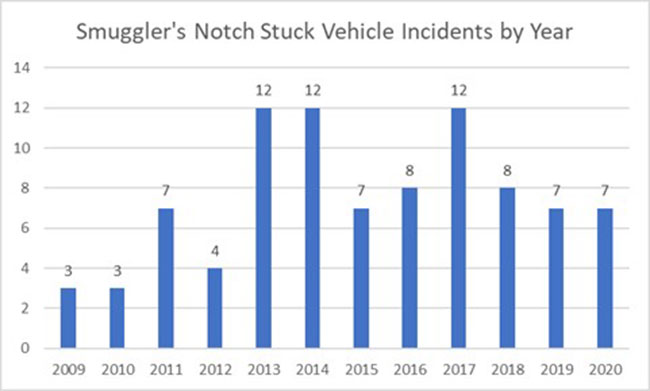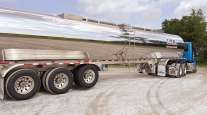Staff Reporter
Vermont Officials Continue Effort to Keep Trucks Out of Smugglers’ Notch

[Stay on top of transportation news: Get TTNews in your inbox.]
Vermont transportation officials are leading an effort to keep large commercial vehicles out of Smugglers’ Notch, a twisting mountain pass on which numerous truckers have gotten stuck over the years.
Smugglers’ Notch, between the towns of Cambridge and Stowe, is a popular area for recreation and skiing due to its proximity to Mount Mansfield. The top of the pass closes to vehicles in the winter because snow plowing becomes too difficult, although the road can still be used to access ski resorts on either side of the mountain.
State Route 108, which runs from Stowe to Quebec, traverses Smugglers’ Notch.

(VTrans)
The Vermont Agency of Transportation’s efforts to keep large freight haulers off the pass stem from the issue of trucks getting stuck on the narrow winding road. VTrans Operations and Safety Bureau Director Joshua Schultz said the peak, which includes a series of curves with rocks and trees abutting the sides of the road, is particularly challenging for drivers of tractor-trailers, buses and campers.
“It almost looks like you’re driving on a hiking trail,” Schultz told Transport Topics. “The issue is with long vehicles. They can’t negotiate around those rocks. The level of stuckness kind of depends on how much of an error they’ve made.”
According to the Vermont Historical Society, the pass’s name dates to the War of 1812, when smugglers would use it to move supplies to and from Canada.
In general, the truckers who have gotten stuck are not local haulers. Drivers, including some from Canada, will try to use the road as a cut-through. Schultz said the department added signs written in French to their series of warnings for truckers.
Capt. Kevin Andrews, chief of safety for the Vermont Department of Motor Vehicles, said local truckers know to avoid Smugglers’ Notch.
Besides static signs and electronic message boards, the effort to prevent trucks from using Smugglers’ Notch involves communicating with GPS companies.
Schultz said GPS programs will often direct truckers through Smugglers’ Notch, and drivers will follow their devices instead of the signs. He said truckers sometimes use smartphone apps that are not specific to truck drivers and do not ask what kind of vehicle they’re operating. Andrews said truck-specific GPS systems are generally more expensive than passenger vehicle systems.
Working with different GPS navigation companies to flag the route as unsuitable for trucks has been difficult, but communication with them continues, Schultz said.
Also, Schultz said VTrans is in the process of forming a collaborative group with representatives of law enforcement, local businesses, neighboring towns and the Agency of Natural Resources.

Signs alert truckers at Smugglers' Notch. (VTrans)
“This is a big priority right now for us,” Schultz said. “This is a challenge because you have businesses and ski areas that all have probably deliveries of big things requiring big trucks. Let’s see what kind of solutions we can come up with and hopefully either solve the problem completely or at least further reduce the number of trucks that get stuck.”
Stuck trucks on Smugglers’ Notch have long been an issue. Since 2009, at least three vehicles per year have gotten stuck on the pass, according to VTrans data. In 2020, seven vehicles became stuck while trying to navigate the route.
Assisting stuck trucks is a costly and time-consuming process, normally taking about four hours. Andrews said moving a truck involves lifting part of the vehicle and repositioning it on the road so there’s more room for the driver to negotiate. When a truck gets stuck, car traffic builds up behind it, leading to further complications for tow trucks to reach the incident.
Andrews explained penalties are issued in the form of a civil traffic ticket. Fines start at $1,197 for drivers who use Smugglers’ Notch when they’re not supposed to. If a driver gets stuck and impedes traffic, the first-offense fine is $2,347. If drivers are “so unfortunate to want to give it another whirl,” Andrews said subsequent violations can be upward of $4,647.
Andrews said these public inconveniences have the potential to become more serious if a person at one of the area’s recreation sites needs aid.
“People hike, people get hurt, people get lost and people get stranded on ledges,” Andrews said. “To have emergency services go up there to have to help somebody is not uncommon, so you can start to see how one of these potential tractor-trailers stuck up there could really potentially play out and impact some other kind of situation.”
Want more news? Listen to today's daily briefing below or go here for more info:


